A player can look good on the front of his card, but it’s what’s on the back that matters. That’s where the player’s stats and accomplishments appear, and where the bigger story of their career really rounds into shape: what they’ve done and where they’ve done it, how well and for how long. The photo on the front might show a guy’s only home run all season; if so, the back of the card will tell you.
Because they’re all grounded in the same categories and expressed in similarly shaped statistics, the numbers on the backs of all those cards can blur together somewhat; they are all different, but they don’t really look that different. For instance there is Bill Hanzlik, who averaged 7.2 points per game during his 10 years in the NBA, spent mostly with the Denver Nuggets. The 6-foot-7 small forward was mostly known for his defense, which means that a lot of what he did best didn’t show up on the back of his trading cards. But he was there, and the proof is in the 12-card set of Nuggets trading cards that the Denver Children’s Hospital released for the 1989–90 season.
What was on the back of these cards mattered, too, although it has nothing to do with stats. The backs of these cards featured a safety tip. Michael Adams told kids to stay away from open windows. Walter Davis offered fire safety tips. Fat Lever said to wear a bike helmet.
Hanzlik’s tip was simple and to the point: “Never put poison in your mouth. And if you see someone put poison in their mouth, you should get help right away.” Hanzlik, surely, is the only athlete whose card-back ever looked like this. And, credit where it is due: The tip is solid. Defector also advises you to avoid putting poison in your mouth. It is our site’s official position on poison. But why is the card worded this way?
Hanzlik doesn’t remember much about the cards—it was 35 years ago—but did have a hazy memory of doing some cards that were different. He’s not sure how the poison tip ended up on the back of his card. “I was a master of the obvious,” Hanzlik says. “But it is good advice!”
The Children’s Hospital continues to get support from Hanzlik, who is now a color commentator for Nuggets broadcasts and still a public-spirited guy. In 1986, he ran a youth basketball clinic in Denver aimed at broadening participation in the game. It was a success. “Wanted to fill a void so more girls could play basketball,” he says. “We gave away all the money we raised—we didn’t want or need it anyway. That was fun. But then we realized if we roll some of it back in, we might be able to do a little more.”
Hanzlik co-founded the Gold Crown Foundation that year. The organization built a 13-acre complex for youth sports, complete with a miniature version of Coors Field. A field house has six basketball courts and eight volleyball courts; it’s booked about 300 days a year and serves about 15,000 kids in the Denver area annually. “We’re just nutso about the work,” Hanzlik says. And 35 years after he and one of Denver’s biggest civic institutions worked together to encourage local youth not to put poison into their mouths, the two are still partnering to help out Denver kids.
That Children’s Hospital set captured my imagination the first time I saw it, via a post by Andy Elrick, but it was not the only one of its kind. Throughout the trading card boom of the 1980s and ’90s, many teams put out card sets featuring a player on the front and a safety tip of some kind on the back. Most of those were done with a local police department, usually in collaboration with a local company. The Nuggets’ collaboration with the Denver Children’s Hospital was co-sponsored by 7-Eleven and Pepsi. Other sets were just a joint effort between the cops and the team.
Not long after talking to Hanzlik, I was able to find a Randall Cunningham card from a set put out jointly by the Eagles, Frito-Lay, and “your local police department.” It featured the basic biographical info you’d find on the back of any card, and a paragraph describing Cunningham’s highlights with the Eagles. It also had a “tip from the sidelines.” It rhymed.
Don’t play in vacant houses, be safe and keep away
Abandoned autos will be towed away,
they’re not for children to stop and play
Again, decent advice. I could see a kid jumping into an abandoned car to pretend to drive it, and somehow injuring himself. Maybe the Eagles would really prevent that from happening! Plus, this was pertinent to local concerns, as Philadelphia has a long history of not towing away vacant autos.
A quick scan of the Trading Card Database shows many sets like these, very few of which have been deemed particularly desirable by collectors. That meant that I was able to purchase a bunch of them on eBay. Most of the card sets have similar themes: Players warn young collectors about stranger danger, drugs, gangs, the perils of running away, and jaywalking, in a voice that is stern, cop-like, and authoritative. In a 1989 Milwaukee Brewers set, Gary Sheffield had some strong words about drugs.

I figured I’d put Defector’s money to good use and share some of the sets, and their related advice, with readers. I’ve also enlisted former Topps employee David Roth to analyze the quality of the cards, as compared to other ones of that era.
1979 San Francisco Giants
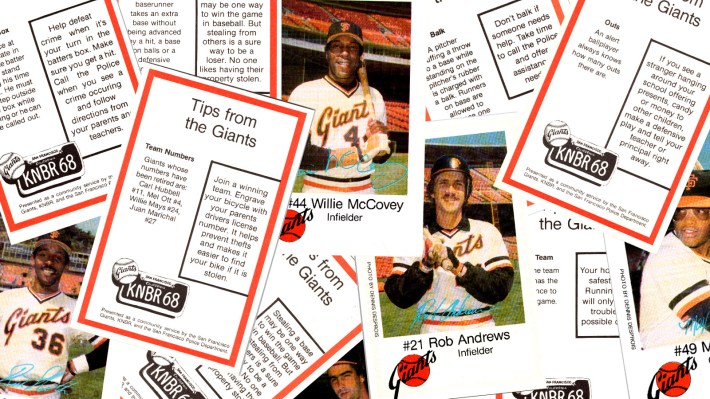
Cards in Set: 30
Sponsors: San Francisco Police Department, KNBR-AM
Notable players: Willie McCovey, Vida Blue
Card front: Posed player photos, with a facsimile autograph
Card back: Definition of a baseball term, followed by a tip that is (often torturously) connected to the definition
These cards try really hard. The back of Willie McCovey’s card contains a definition of stealing, followed by this tip: “Stealing a base may be one way to win the game in baseball. But stealing from others is a sure way to be a loser. No one likes having their property stolen.” I mean, I would listen if I were a kid in 1979 and Willie McCovey told me I shouldn’t be a loser.
All of the cards are like this. Tom Hallar: “Don’t let yourself get caught in a run down. Using drugs will tag you out.” Manager Joe Altobelli: “Help pick off the burglar. Report suspicious persons in your neighborhood.” Larry Shepard, a coach: “It’s a grand slam when your parents secure your home properly and practice good crime prevention methods at all times.” Johnnie LeMaster: “Help defeat crime when it’s your turn in the batters box. Make sure you get a hit. Call the Police when you see a crime occurring and follow directions from your parents and teachers.” Jack Clark: “You can increase your average against becoming a traffic statistic by obeying traffic safety rules.” John Curtis: “Don’t let your friends foul you up by talking you into shoplifting.”
Not all of the attempts at connecting the tip to a baseball term are quite as artful as those. Bill Madlock’s card: “If you see a stranger hanging around your school offering presents, candy or money to other children, make a defensive play and tell your teacher or principal right away.” This is connected to the definition of out. Rennie Stennett: “It’s only a short distance from shoplifting to burglary. Don’t take the first step.” I have no idea how this connects to shortstop, though maybe it’s the “short distance” part. Darrell Evans: “If you see a crime occurring or if someone bothers you make a line drive for the police and report it.” I have to say, the xBA on these cards is pretty low.
Roth’s Analysis: As baseball cards, these look extremely homemade, which is more or less to be expected. But I like how 1979 Bay Area all the photos are, and the dedication to including both coaches and backup catchers is laudable. Joe Altobelli, smiling though he is in his photo, looks like someone who’d yell at Gene Hackman in a movie, which in my opinion makes his advice to call the cops on people you see acting weird much more effective. We are not looking for beautiful baseball cards, here, so much as we are looking for a full-spectrum experience of what it would be like to be given weird advice by degenerate Carter-era ballplayer types. By that standards, these succeed.
1984 Milwaukee Brewers
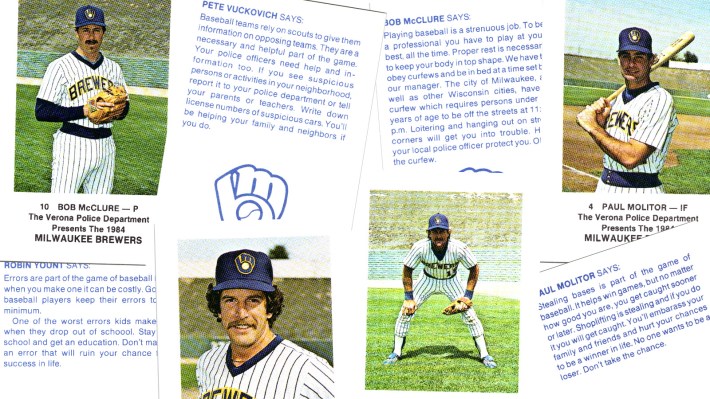
Cards in Set: 30
Sponsors: Various local police departments
Notable players: Paul Molitor, Robin Yount, Rollie Fingers, Don Sutton,
Card front: An action or posed shot of the player
Card back: A tip allegedly from the player
Each card in this set contains detailed advice from a player on the Brewers. Those players tell kids to avoid drugs, shoplifting, jaywalking, and construction sites. And, yes, a baseball player tells the kids to stop cursing. “When a baseball player uses foul language the umpire ejects him from the game,” Moose Haas says. “There is no reason for profanity on the field or off. Courtesy and consideration for other people always pay off; foul language never impresses anyone.”
Roth’s Analysis: I should recuse myself from this one by rights because I had encountered this set before: The Bob McClure card where he tells the youth to abide by their towns’ curfews was in a big box of commons that someone sent to the old Deadspin offices for us to use on Remember Some Guys videos. As low-effort as these cards look—all the pictures were plainly taken on the same overcast day at the spring training facility—I can assure you that the product felt even cheaper in your hand. I think this would make it harder to take the good advice on offer. Randy Ready is right when he says you should “choose your advisers closely.”
1984 and 1985 Philadelphia Eagles

Cards in Set: 8 and 16, respectively
Sponsors: Frito Lay, “your local police department”
Notable players: Mike Quick, Ron Jaworski, barefoot kicker Paul McFadden
Card front: An action shot of the player
Card back: Career highlights, basic stats, a tip presented by a drawing of a cheerleader
Some of the advice on these cards rhymes. That Randall Cunningham advice from 1986 is also on Anthony Griggs’s card in the 1985 set. Ron Jaworski has two rhyming tips for swimmers: “Where there is a lifeguard, there you stay, he’ll help to keep danger away. Swimming is for two or more, not for one; then it’s safer and lots more fun.”
My favorite tip comes from Mike Quick in 1984, and also Vyto Kab in 1985: “When you use drugs and alcohol, you are ‘far-out.’ It’s a one way ticket going nowhere. Join the ‘in’ crowd and stay away from the drug and alcohol scene.”
Roth’s Analysis: Now we’re talking. These don’t really look that much worse than the non-Topps baseball products that were coming out around this time, and I like how busy the back is. You’ve got some moderately sassy clip art, some rip-and-run biographical stuff from the media guide, and a piece of Timeless Police Wisdom dressed up in some of the most berserk poetic meter I’ve encountered anywhere. A public service in every facet.
1989 Buffalo Bills
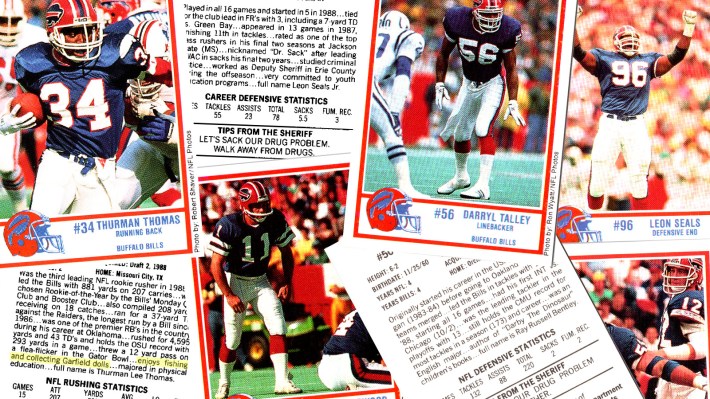
Cards in Set: 8
Sponsors: Erie County Sheriff’s Dept., Louis Rich Turkey Products
Notable players: Thurman Thomas, Darryl Talley, (sigh) Scott Norwood
Card front: Player on field, but six photos are taken before or after a play
Card back: Basic stats, career highlights and bio, tip from the sheriff
The tips on these cards are all about drugs and are not very helpful. Let’s tackle the drug problem together. We can run drugs out of our neighborhoods. Let’s kick drugs out of our schools. Let’s sack our drug problem. Great. What the heck is a kid supposed to do with this information?
The backs of these cards may not do much to stop drug misuse, but they do contain the occasional bit of fascinating information. Jim Richter enjoys backgammon and racquetball. Ray Bentley is the author of the Darby The Dinosaur books. And, most importantly, Thurman Thomas enjoys fishing and collecting Garfield dolls. “It all started after my junior season,” Thomas said in 1989. “I was really depressed about the year, and I was reading the comics when I came across Garfield. It lifted my spirits. I kept reading it, and after awhile I started collecting them.”
Roth’s Analysis: Another instance in which the photos and overall design aesthetic on the front aren’t really that much worse than a lot of the cards that companies were charging money for. Given that these cards were almost certainly given out by grim YMCA workers and literal police officers, that’s over-delivering and should be celebrated. Otherwise, sadly, there’s not a lot to hang your hat on. The media guide stuff on the back is welcome; the police department’s contribution is subpar even by the standards at work here. “Here’s a tip: let’s get drugs out of our schools.” Good note, dude. I’m going to do that right now.
1989 Los Angeles Dodgers
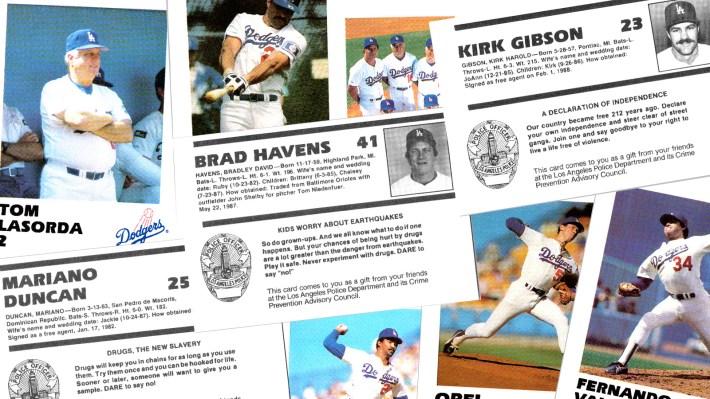
Cards in Set: 30
Sponsors: “Your friends at the Los Angeles Police Department and its Crime Prevention Advisory Council”
Notable players: Kirk Gibson, Steve Sax, Tommy Lasorda, Orel Hershiser, Fernando Valenzuela
Card front: Mostly action shots of players
Card back: Player birthdate, height, weight, wife’s name and wedding date, children’s name and birthdate; a safety tip from the player and the LAPD
One cool thing about baseball cards put out by police departments is that they have no experience producing such a product. They are making outsider art in baseball card form. As such, these cards from the LAPD contain an absolutely bonkers amount of information about players on the 1989 Los Angeles Dodgers. I was not messing with you earlier: These cards contain a player’s wife’s name and wedding date and the names and birthdates of their kids. There is probably enough on the back of Pedro Guerrero’s LAPD baseball card to steal his identity.
If you’ve ever heard anything about the LAPD in the late 1980s, or I guess also any other time in its history, you’ll have an idea of the tone of the advice on these cards. “IS YOUR FRIEND A GANG MEMBER?” reads the back of Steve Sax’s card. “Maybe he is. Maybe he’s been trying to get you to join up. Sounds pretty good, doesn’t it? Don’t be fooled. Street gangs are poison. Bad medicine. An invitation to jail. Have the courage to live your own life.” Tim Leary’s card assumes children are already familiar with a lethal game of chance: “YOU DON’T NEED A GUN… to play Russian Roulette. Drugs can be just as deadly. Don’t let the people you know talk you into using drugs. You have the right to say ‘no!’ Use that right and save your future.” The LAPD has a pretty low opinion of Los Angeles children, huh? These druggies keep inviting their friends to join a gang!
“Street gangs in our city have their own Hall of Shame,” reads Jeff Hamilton’s card. “Last year they killed 205 people and committed 1,711 robberies. Don’t ever get involved with these young criminals. Keep clean.” OK, but Steve Sax told me that joining a gang sounds pretty good?
Roth’s Analysis: Aesthetically, these remind me less of any baseball card I’ve seen and more of the athlete posters that I remember from my middle school’s weight room, and as someone who has fond memories of lifting very small amounts of weight under a poster with a blurry image, big white border, and the words JACK HAM on it, I have to give them points for that, and for the very 1989 font. Everything on the back is obviously insane. Do not give me a Mariano Duncan card and put the words “Drugs, The New Slavery” on the back of it. I don’t want that.
1990 Indianapolis Colts
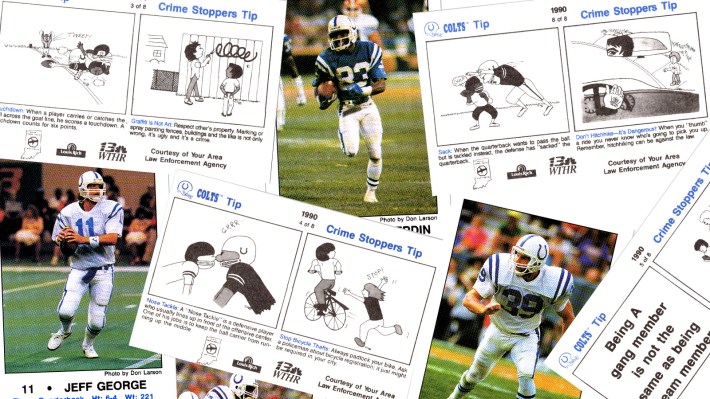
Cards in Set: 8
Sponsors: Central Indiana Crime Stoppers, Louis Rich Turkey Products, WTHR-TV 13, “Your Area Law Enforcement Agency”
Notable players: Jeff George, Clarence Verdin
Card front: Action shot of player, along with position, height and weight
Card back: A cartoon defining a football term, next to a cartoon providing some advice
These comics are great. The football ones are enjoyable enough, but the PSA toons really make this set memorable.

This is the back of Jeff George’s card. It literally contains a cartoon of kids armed with chains, like they are enemies in the NES game River City Ransom, calling another child a sissy for not picking up a chain and joining their gang.

Oh, 1990 Indianapolis Colts, you would be so disappointed to learn about the respectability of graffiti art in 2025.
Roth’s Analysis: The front of the cards are a disaster, although I like the extremely low-gloss photography. But the layout looks cheap and weird, and while I will give some points for it looking like what it is, which is a child’s product crafted by or in close collaboration with the Indianapolis Police Department in 1990, I can’t say that it looks good. Dan is right about everything on the back, which is amazing. It is once again identifiably the product of a specific moment and a specific metro PD, but I also think this is more or less how police officers see the world.
1990 Milwaukee Brewers
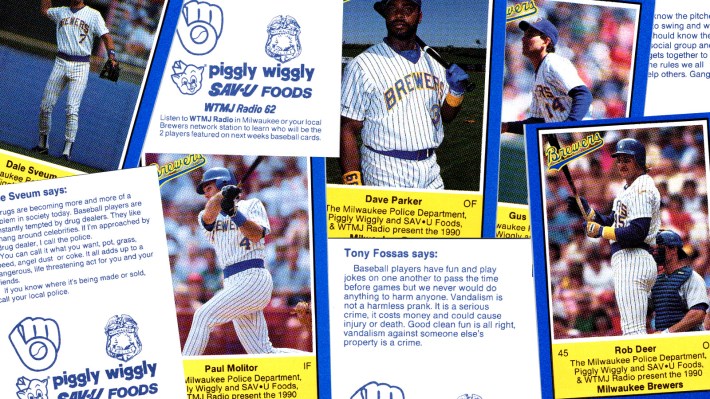
Cards in Set: 30
Sponsors: Milwaukee Police, Piggly Wiggly, Sav•U Foods, WTMJ Radio
Notable players: Gary Sheffield, Robin Yount, Paul Molitor
Card front: Generally an action shot of a player
Card back: A tip for kids allegedly delivered by the player himself
Six years have passed. The advice from the Milwaukee Brewers remains basically the same: Avoid drugs, reject the temptation of jaywalking, et cetera. Dave Parker says to “obey the curfew and you’ll be a better person for it.” Ted Higuera warns to “never trust a stranger, no matter how friendly they might be.” Tony Fossas calls vandalism a “serious crime.”
Paul Monitor has this advice: “Write down license numbers of suspicious cars. You’ll be helping your family and neighbors if you do.” Don’t jaywalk while getting that license plate number. There’s also a bit of familiar advice from Dale Sveum.
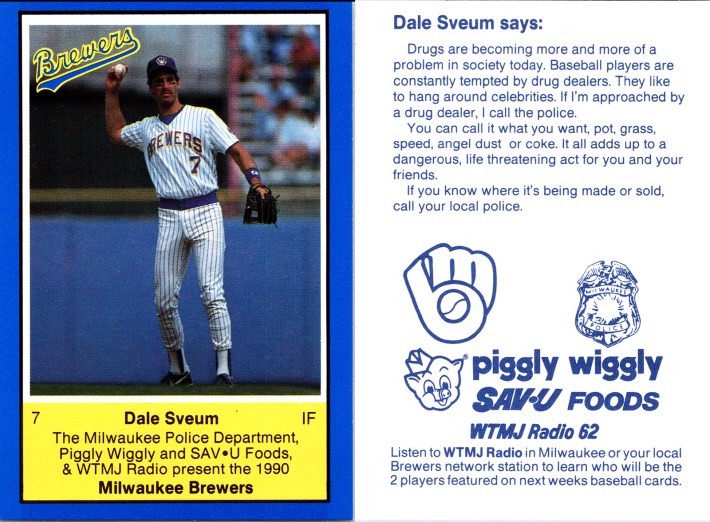
No matter the year, the Milwaukee Brewers were constantly hounded by drug dealers.
Roth’s Analysis: The top two-thirds of the card could be a Score product from that very year, which is not entirely a compliment but I think pretty close to a statement of fact. The bottom third, where it’s just a bunch of tiny text stacked up like a Surgeon General’s Warning, is not like that, and that is entirely not a compliment. I do like that the text on the back is kind of discursive and voice-y. That really does seem to be a thought that just popped into Dale Sveum’s head, just something he’d been thinking about vis-a-vis the way that drugs have become more of a problem in society today, or just how Rob Deer chose to work his way around to making the point that you shouldn’t run away from home.
1992 Denver Nuggets
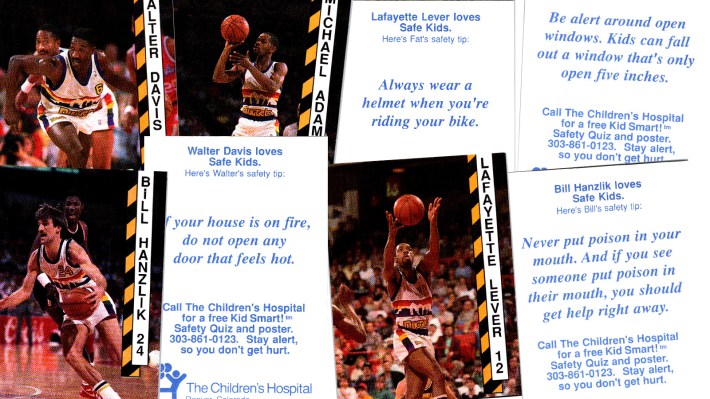
Cards in Set: 24
Sponsors: Pepsi, 7-Eleven, The Children’s Hospital of Denver Colorado
Notable players: Bill “Don’t Put Poison In Your Mouth” Hanzlik, Fat Lever,
Card front: Action shot of player
Card back: A tip from the player, a phone number to call to get free stuff from the children’s hospital
Bill Hanzlik tells kids not to put poison in their mouth, the greatest tip of all time. But what I also like about these cards is nearly every player is making a funny face on their card.
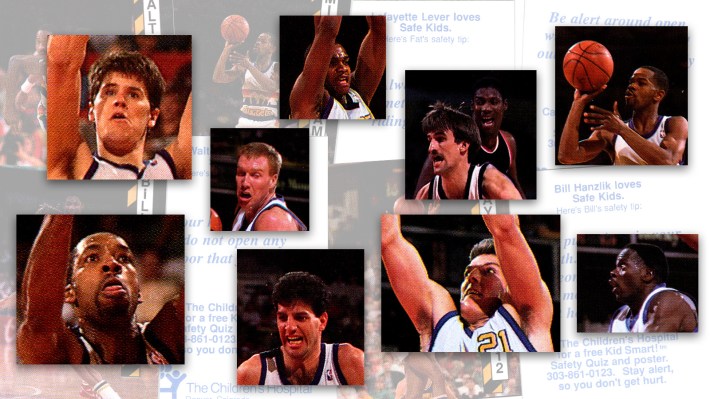
Roth’s Analysis: The funny faces aside—and I would encourage Dan to try running Doug Moe’s offense at altitude before throwing any stones, there—these are some of the most outrageously shitty looking cards I’ve ever seen. I do not understand the black and yellow vertical bit, the lettering is confusing to the eye, and while the photos are all at least “of basketball action” basically none of them, with all due respect to a grimacing Tim Kempton grabbing a rebound, depict any aspects of the game that people actually enjoy watching. The backs look cheap and bad, but in a way that I came to like as I looked through the set. There’s not even really an attempt to make it look like a trading card, just a note to say that Dan Schayes Loves Safe Kids and wishes you’d wear your seatbelt. I don’t like the cards, but I have no choice but to respect how little they seem to care about being cards.
1995 Milwaukee Brewers
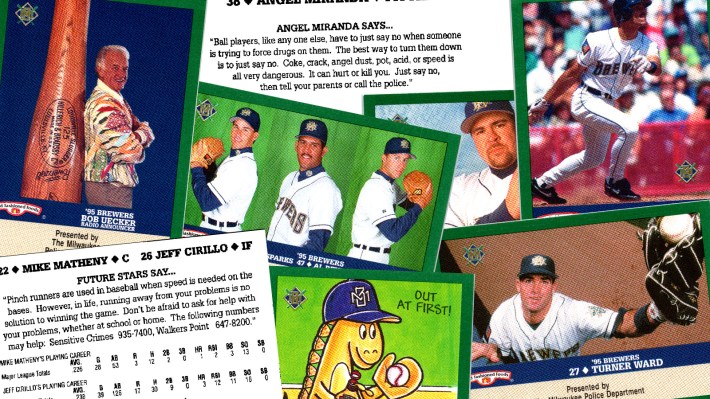
Cards in Set: 33
Sponsors: Milwaukee PD and Old Fashioned Foods
Notable players: Bob Uecker, Mike Matheny, Squeezasaurus (the mascot for SqueezeCheese)
Card front: Posed photos and action shots
Card back: A tip purportedly said by a player, career totals
Like Paul Molitor in 1990, several Milwaukee Brewers advise kids to write down the license plate numbers of suspicious cars. There are bike safety tips. Players tell kids to avoid shoplifting, drugs, and gangs. Several say to join a youth church or scouting group.
“Drinking alcoholic beverages does not make you ‘cool,'” Darryl Hamilton says. “It can make you very sick and destroy some of the best years of your life.” Turner Ward spins this baseball connection: “One of the most challenging plays in baseball is the hit and run. On the street a hit and run play consists of vandalism or graffiti.”
Roth’s Analysis: Layout-wise, they are in the ballpark with other card designs from that period. The absolute lack of effort on the photographs is impossible to read as anything but a flex. Basically you’ve got “Derrick May is going to stand there in front of a green tarp in the basement, and he’s going to put you up on some free game re: calling the cops on your neighbors,” or you’ve got “blurry grimacing Kevin Seitzer tells kids that ‘going on a vacation or business trip is always exciting’ and encourages them to put their lights on a timer.” Neither is an appealing pitch, visually or otherwise, but both are so overtly punitive in that sense that I can only tip my cap. Please imagine that I have connected every baseball-style formulation in italics above to some kind of anti-graffiti message, I do not currently have the time to do that.




